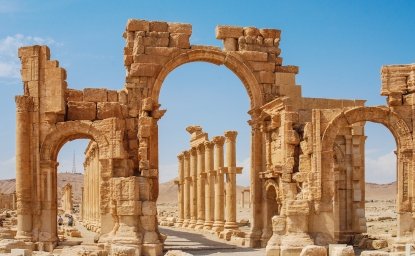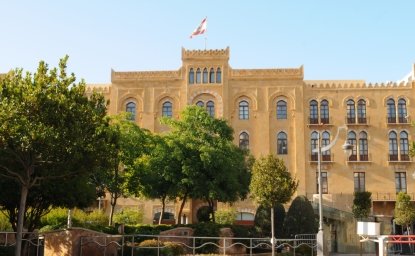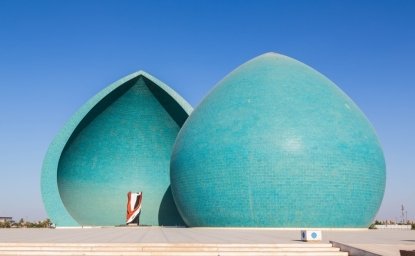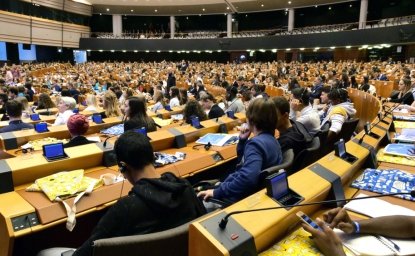 Note: The cover story of the November 2005 issue of Centerpoint was adapted from this slightly longer version.
Note: The cover story of the November 2005 issue of Centerpoint was adapted from this slightly longer version.
On September 26, the Wilson Center's MIDDLE EAST PROGRAM assembled journalists and academics from around the world to discuss the state of reporting in their respective countries based on their impressions and experiences. Panelists discussed journalists' access to, and freedom to disseminate, information and the media's impact on public opinion and public policy.
Reporting from Restricted Areas
 In some countries, journalists face numerous challenges while trying to cover the news in an inhospitable environment. USA Today Senior Diplomatic Correspondent Barbara Slavin, who chaired this panel, recounted living in China in the early 1980s when she and her husband, the UPI bureau chief in Beijing, discovered their house was bugged.
In some countries, journalists face numerous challenges while trying to cover the news in an inhospitable environment. USA Today Senior Diplomatic Correspondent Barbara Slavin, who chaired this panel, recounted living in China in the early 1980s when she and her husband, the UPI bureau chief in Beijing, discovered their house was bugged.
Today, in China, the Communist Party still often restricts news coverage it deems sensitive or embarrassing, but limited freedom and commercial interests prevent the Party from dictating the news.  "Chinese media moves very slowly toward freedom," said Qian Gang, director of the China Media Project at the University of Hong Kong. "At the same time, they leap headfirst into the marketplace."
"Chinese media moves very slowly toward freedom," said Qian Gang, director of the China Media Project at the University of Hong Kong. "At the same time, they leap headfirst into the marketplace."
China's economic reforms of the past quarter-century started a trend toward market-oriented media. But unlimited commercialization has led to uniformity and a trivialization of the news, pushing stories that grab attention and help increase newspaper circulation.
Today, China has 11 times the number of newspapers it did in 1978. While most of them enjoy commercial success and support political reform, "they cannot fully play the role as a watchdog."
This became evident during the SARS epidemic in 2003, Qian said, a story the government quickly suppressed to contain public fear, denying, despite many fatalities, a health threat. Since this debacle, reporting on disasters has improved but the government still tightly controls what information to release, what Qian labeled "the guidance of public opinion."
 Iran also tries to keep a tight grip on information. Azadeh Moaveni, an Iranian-American who is a journalist for Time Magazine in Tehran, said Iranian officials send directives to editors on how to cover sensitive material. For example, the state directed journalists to frame nuclear energy in terms of national sovereignty rather than debating the utility of nuclear power. Also, as the Internet grows in popularity, so does state control. Moaveni said a branch of the judiciary oversees that Internet service providers issue a special box that blocks numerous websites, particularly political sites.
Iran also tries to keep a tight grip on information. Azadeh Moaveni, an Iranian-American who is a journalist for Time Magazine in Tehran, said Iranian officials send directives to editors on how to cover sensitive material. For example, the state directed journalists to frame nuclear energy in terms of national sovereignty rather than debating the utility of nuclear power. Also, as the Internet grows in popularity, so does state control. Moaveni said a branch of the judiciary oversees that Internet service providers issue a special box that blocks numerous websites, particularly political sites.
In the late 1990s, "Iranian journalists were doing truly groundbreaking work in areas that were taboo," such as polling and investigations into political killings, said Moaveni. "This kind of scandal-producing journalism in the print media was truly remarkable for the political atmosphere." But in 2000, hardliners instigated a media crackdown, shutting down 200 reformist newspapers, imprisoning journalists who criticized the government, and creating the hostile work environment that still exists today.
Since 2000, the Iranian government has exercised media control through intimidation. Moaveni said, "The implicit redlines and self-censorship that journalists take upon themselves is part of the culture of covering news in Iran." But some media outlets push the red lines more indirectly, she added, such as the large reformist newspaper Shargh, which implies criticism of the state through reporting on social issues. Meanwhile, the recent election of hardliner President Mahmoud Ahmadinejad leaves little hope for a thaw in media control anytime soon.
 Wilson Center Fellow Marta Dyczok, a Canadian-Ukrainian who teaches at the University of Western Ontario, focused on how little media has changed in Ukraine from the early-mid 1990s when she was a foreign correspondent there. While Ukraine technically is no longer a restricted area, numerous problems remain that threaten democratic development.
Wilson Center Fellow Marta Dyczok, a Canadian-Ukrainian who teaches at the University of Western Ontario, focused on how little media has changed in Ukraine from the early-mid 1990s when she was a foreign correspondent there. While Ukraine technically is no longer a restricted area, numerous problems remain that threaten democratic development.
When the Soviet Union collapsed, Party propaganda and censorship disappeared but censorship reappeared by the mid-late 1990s. In fact, Dyczok said, former President Kuchma was labeled one of the worst enemies of free speech. Today, the overall quality of journalism is low, she said, as journalists grapple with their role in a changing Ukraine, often failing to investigate leads—particularly ones involving allegations of government corruption—and not checking and documenting sources.
Dyczok said government media control can influence public opinion but cannot quash public discontent, whether it's the 1989 protests in Tiananmen Square or the 2004 protests in Ukraine that sparked the Orange Revolution. "After five years of censorship, Ukrainians went out on the street and protested," she said. "Just because you control media, it doesn't mean you'll be able to control public opinion or [prevent] public protest."
Influencing Public Policy
 This panel discussed whether journalists help drive policy, particularly in conflict situations. Ralph Begleiter, who chaired this session, is a communications professor and former CNN World Affairs correspondent. When he became a CNN correspondent in the early 1980s, the then-fledgling all-news television network seemed to influence public policy by airing bold, recurring news images, visible globally, which became known as "the CNN Effect."
This panel discussed whether journalists help drive policy, particularly in conflict situations. Ralph Begleiter, who chaired this session, is a communications professor and former CNN World Affairs correspondent. When he became a CNN correspondent in the early 1980s, the then-fledgling all-news television network seemed to influence public policy by airing bold, recurring news images, visible globally, which became known as "the CNN Effect."
 Author and former editorial writer for The New York Times Bill Berkeley is writing a book on the 1979-1980 Iranian Hostage Crisis—the first major international event to exemplify the CNN Effect. He said dramatic television images showing Iranian crowds chanting "death to America" affected U.S. perceptions and policy.
Author and former editorial writer for The New York Times Bill Berkeley is writing a book on the 1979-1980 Iranian Hostage Crisis—the first major international event to exemplify the CNN Effect. He said dramatic television images showing Iranian crowds chanting "death to America" affected U.S. perceptions and policy.
Berkeley focused his remarks on Africa, where he had reported for more than a decade. He said in countries such as Somalia, Ethiopia, and Sudan, "television images of suffering, particularly of famine and war, have had a dramatic impact on public policy and yielded fundamentally better decisions than would have been made in the absence of such images."
However, he said, the U.S. media too often reinforces racist stereotypes toward Africa, which can deter needed intervention. For example, he cited an article depicting an incident of cannibalism in the Congo as a practice pervasive across Africa, stemming from Africans' "primitive culture," when in fact most Africans abhor the practice. He also dispelled the deep-rooted, widely held perception that Africans are slaughtering each other "for exotic reasons
for reasons we cannot understand that are foreign to our culture." Wars occur in Africa for much the same reasons as elsewhere, he said, due to struggles for power, money, and land.
Given America's failure to intervene in previous African conflicts, Berkeley said he never expected his reporting in Rwanda to prod Washington to intervene there. "Overwhelmingly, the history of American coverage of Africa is one that reinforces stereotypes of Africans that serve as a disincentive to enlightened engagement."
 Media also seems to have little impact on decision-makers in Indonesia, said Lukas Luwarso, the executive secretary of the Indonesian Press Council. While media outlets and press freedom burgeoned when the Suharto regime's 35-year reign ended in 1998, he said, journalists have abused that freedom and the quality and ethics of journalism remain low. Officials tend to ignore media reports.
Media also seems to have little impact on decision-makers in Indonesia, said Lukas Luwarso, the executive secretary of the Indonesian Press Council. While media outlets and press freedom burgeoned when the Suharto regime's 35-year reign ended in 1998, he said, journalists have abused that freedom and the quality and ethics of journalism remain low. Officials tend to ignore media reports.
Since 1998, print media leapt from 200 publications to 1,600 and broadcast media jumped from one state-owned television and radio station to 1,700 radio and 11 television stations nationwide. Despite this increase, major news media are concentrated in urban areas, with little reliable coverage in the rural areas where the major conflicts occur. In addition, media reporting is polarized, with little cross-cultural reporting among ethnic groups.
"In conflict areas, when you try to become objective and independent, you [tend to] become the common enemy of the conflicting party," Luwarso said. Therefore, the Indonesian Press Council advises journalists to delay reporting on or broadcasting hot, violent conflict, to prevent retribution and further violence. For Indonesia, he said, "Press freedom became very dangerous for public perception."
Perceptions of Iraq
 The Washington Post sent Islamic correspondent Anthony Shadid to Baghdad in March 2003, a few weeks before U.S. troops invaded. He remained in Iraq covering the war for two years. Last year, his human-interest stories for the Post earned him a Pulitzer Prize for international reporting. Shadid, in a third session, described his new book, Night Draws Near: Iraq's People in the Shadow of America's War, as a narrative of ordinary people enduring extraordinary circumstances.
The Washington Post sent Islamic correspondent Anthony Shadid to Baghdad in March 2003, a few weeks before U.S. troops invaded. He remained in Iraq covering the war for two years. Last year, his human-interest stories for the Post earned him a Pulitzer Prize for international reporting. Shadid, in a third session, described his new book, Night Draws Near: Iraq's People in the Shadow of America's War, as a narrative of ordinary people enduring extraordinary circumstances.
One man who reappears throughout the book was an outspoken academic named Wamidh who opposed the war. Shadid described him as "a voice splashed in color across
a monochromatic landscape."
Shadid said the media's emphasis on repression blinded us to the larger story. He said the war was both an occupation and liberation, and "the United States was a catalyst for consequences that most of us never foresaw." His book aims to give a voice to Iraqis with compelling stories to tell, ones that evoke images of suffering from years of repression and war.
While reporting in Iraq, Shadid said he grappled with his identity as an Arab-American and his role as an objective journalist. As he tried to make sense of a war that forced two estranged cultures to occupy one space, he observed, "The U.S. experience in Iraq, at a certain level, was a microcosm of America's broader struggle with the Arab world. I think it's a generational battle that revolves around these axes of religion, culture, and identity.
"I've come to cringe at words like liberation and democracy," which he said have been overused and distort the Iraqi experience. He added, "The longer I was there, the less I understood it."
Journalism among Neighbors
Last year, the Center's MEXICO INSTITUTE convened two conferences also to delve into the challenges reporters face. To continue this debate, the MEXICO INSTITUTE released a compendium of articles, Writing Beyond Boundaries: Journalism across the U.S.-Mexico Border, in conjunction with Foreign Affairs en Español.
Overall, journalists in Mexico and the United States are writing more stories about the other than ever before, but the same subjects tend to surface repeatedly: immigration, drugs, trade, and corruption. And while bilateral concerns such as border security and the environment increasingly are covered, the publication's contributing authors underscore the need for a deeper understanding of each other's cultures through nontraditional stories to portray a more complete, unbiased picture of the other.
Journalists and editors on both sides of the border face similar constraints. Many admit to scarce resources due to competing interests and the pressure to publish headline-grabbing news often at the sacrifice of investigative reporting. Despite these challenges, journalists are writing more frequently about political and social changes, offering fresh perspectives on complex debates on such topics as migrant lives, education, and elections. They also acknowledge greater bilateral collaboration, in which Mexican and U.S. newspapers and networks swap and translate stories.
The authors in this volume-—themselves editors, journalists, and publishers-—urge journalists working in Mexico and the United States to phase out old stereotypes, increase stories about the lives of ordinary citizens, and report from beyond the capital cities. As stated in the publication's introduction by MEXICO INSTITUTE Director Andrew Selee and Program Assistant Heidy Servin-Baez, the challenge is "to break out of the constraints of international coverage that reports on ‘the other,' to cover instead a ‘we' composed of two societies that share a common continent and a common future."
Related Links




